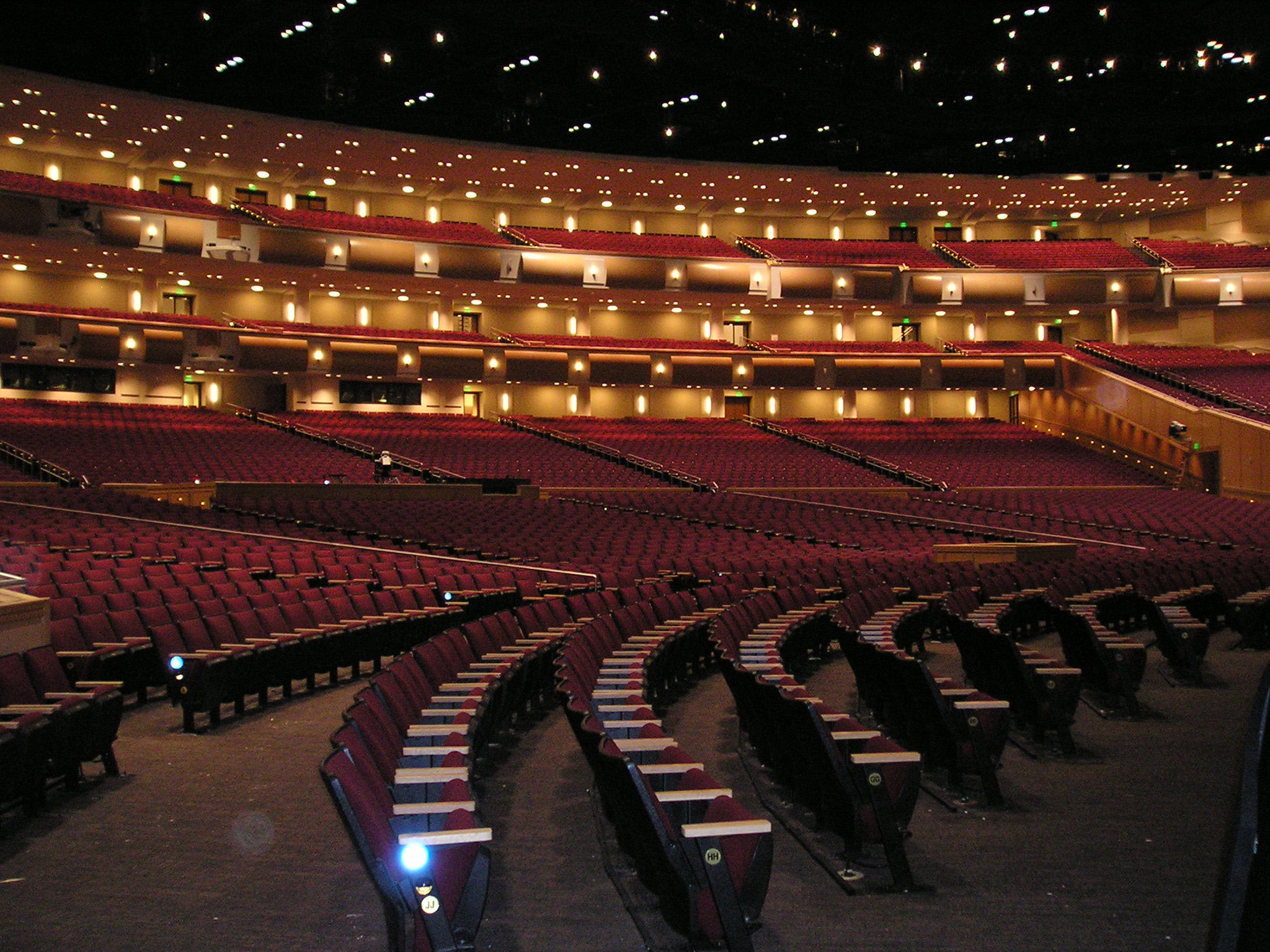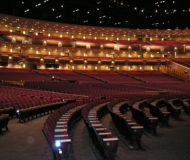The BYU-Idaho Center’s 337,000 sq.ft auditorium is a full stage-house theatre—and its sound system is complex, in response to the building’s interior architectural design. In a combined point-source and distributed design using NEXO systems components, three main L-C-R clusters hang in front of the 105’x70’ stage. Left and right arrays house 18x GEO D10 speakers in each cluster, configured such that at the bottom of each array, a NEXO S1230 side-fill fires downward, a design to address the auditorium’s enormous fan-shaped design.
The centre array consists of 14x GEO D10 cabinets, with 4x S1210s as down-fills paired on each side of the cluster. There are four NEXO GEO Sub subwoofers at the top of each cluster. “The sub frequency cabinets are positioned at the top of each cluster, and the D10 boxes are precisely aimed downward to suit maximum evenness of coverage in the vertical plane,” says Andy Prager, senior project engineer at Diversified Systems, the systems integrator on the project. “There was concern about placing the subs at such a high elevation in this large volume open space, [since] there’s a lot of air to push. So it was decided to add subs to the design, where under certain circumstances—such as amplified music performances—dual-stacked GEO Subs could be rolled out on each side of the stage, using separate mix outputs from the DiGiCo SD7 console. Since both flown and stage subs have discrete mix output channels from the console, the mix engineer can use faders as a gas pedal to suit sub-frequency gain requirements.”
While music is one of the applications for the auditorium, as well as theatre performances and large group meetings, the overriding mandate for the systems’ performance was that its speech quality be highly intelligible since its primary mission was the weekly devotional services. “The challenge was to get even and highly intelligible coverage throughout the entire auditorium, despite there being some architectural challenges,” says Prager. With a goal set of ±2dB variation within the space, there is no more than ±3dB variation in level with frequency response up to 12Khz. These included the raked angle callipers on the sides and two jutting balconies necessary to accommodate 15,000 seats into the space.
Starting nearly five years ago, the project’s loudspeaker design began to be modelled by acousticians Ben Seep and Ed Logsdon of D. L. Adams Associates based on the architectural renderings, using the EASE software program. Kenneth R. Fause, a principal at Auerbach Pollock Friedlander, handled subsequent follow-up with EASE modeling. Prager says the PA system design and components underwent numerous revisions over subsequent years.
“One of the big lessons you take away from a project of this size and scale is that over the course of such a long time, products change and new versions become available,” he says. For instance, while a Yamaha PA system had been chosen early on based on the use of NEXO components in other areas of the campus (there is a GEO S8 system in the cafeteria), components changed over time, with the under-balcony delay speakers changing from short D10 stacks to Danley Sound Labs, to in-ceiling JBLs, and eventually to NEXO S1230s. The introduction of the NEXO Nxamp 4×1 and 4×4 amplifiers integrated with loudspeaker processing changed the system design fundamentally. “We were able to deliver the MADI digital signal from the mixing console to the Yamaha DSPs, utilizing EtherSound outputs, directly to the amplifiers without any digital-to-analog conversions,” says Prager. “Because we’re not running audio on the network, there’s minimum latency, and if the network were to fail, you’re not going to lose audio.”
Getting coverage to the balcony areas was crucial. “There are three levels of balcony fills: over-balcony, under-balcony, and under mezzanine,” Prager says. “There’s a natural combination of high-frequency and SPL loss over distance, so the design calls for [the fills] to pick up the sound from the delayed speakers right at the point where the top end rolls off when someone is seated in a certain position in order to maintain high intelligibility and evenness of sound. The balconies will cut the upper frequencies off faster than the mids.”
David Mann says that 107x NEXO S1230 speakers were used to distribute sound in the delay fill areas, each with its own amplifier channel and DSP processing, which is used to sum the three-channel L-C-R audio signals to mono. However, that is mix-matrixed with EQ and delay to favour the appropriate channel on either side of room (the left half of the room in the distributed system would hear more of what is coming from the left side of the hanging cluster). “Having the audio sources directly overhead can be distracting to the listener, and this helps keep the focus on the stage as well as keep the [stereo] image intact,” Mann says.
The S1230s are mounted within ceiling soffits using a U-bracket and covered with acoustically transparent custom grilles. A series of 15x front-fill speakers use a combination of NEXO S1210 and S1230 cabinets with 80-degree and 120-degree horizontal dispersion patterns, with 30-degree vertical dispersion patterns. These fill speakers under the stage lip enhance the audio for the front 10 rows, are also L-C-R mix-matrixed, and delayed to the main line arrays.
Mann says the fill part of the system at the rear of the hall needed to be highly controllable and directional to match the NEXO line array, which is able to be very precisely steered and targeted. “On the left and right line array hangs, the 18 boxes are grouped in threes. That lets us divide each array into six sections of three boxes each that we can shade with various types of EQ and other processing to do things like compensate for air loss in the longer throws,” he says. The quality of the signal chain extends all the way to the podium, where a Schoeps CMC 6 microphone with a high-rejection MK4 cardioid capsule is positioned. “The lectern is almost directly under the center cluster and gain-before-feedback would be a potentially big problem, so we had to use a microphone with very high extraneous noise rejection capability,” he says.
At the centre cluster, there is also an array of 5x NEXO Geo D10 speakers firing toward the stage for the choir during a performance. NEXO amplifiers located in four different rooms, each housing an average of 16 amps, drive all of the speakers. A fifth amp room is used to drive the 60x downfiring speakers that feed the 10 basketball courts directly adjacent to the theatre.
[Thanks to Dan Daley, writing in the May 2011 issue of SVC Online, for much of this article.]
* You can download a pdf of his article from the Support page of the NEXO website.

















































